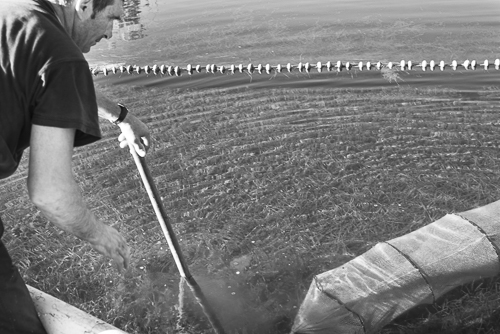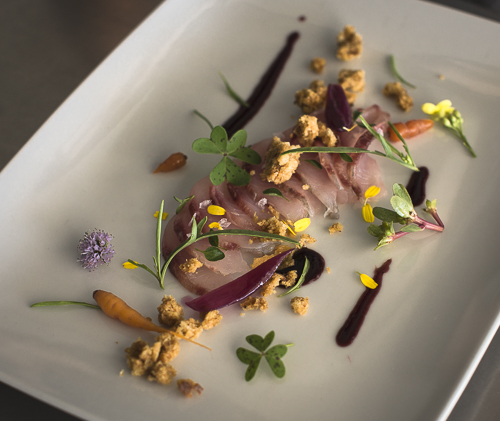Having passed the breakwater connecting the remains of the ancient Punic-Roman town of Nora and the islet Fradis Minoris, we met Giovanni Lenti, the manager of the Fishermen’s Cooperative of Nora together with Mario, a fisherman who had just started catching fish from the lagoon bordering the breakwater.
We had arrived at the sandstone islet which together with the breakwater serve as a barrier between the sea and a lagoon being fed by two mouths, which can be opened or closed, connecting the lagoon and the sea. In fact, the breakwater was built in 1957, increasing the area of the lagoon and serving as a bridge between the mainland and the islet.
The lagoon, the islet with its surrounding dune and the sea are three different eco-systems, which are also connected and interdependent. In the past, like now, the islet has always been useful for fishing in both the lagoon and the sea.
While the Romans used the islet as a quarry for sandstone, traces which can easily be seen, the Catholic Church took possession of it in the Middle Ages. Then, the islet was used as a base for fishing and preparing the fish for consumption. Since the islet is called Fradis Minoris, which is Sardinian for Fratres Minoris in Latin, meaning Minor Brothers, it’s probable that a monastery has been on the islet.
In the 20th century, private persons were given a concession to the islet and to fish in the lagoon until the 1980s when the commune decided to regain full ownership since the last owner gave up the concession and let it be known that the concession could be given to a better one. At the same time, a local golf club wanted to turn the islet together with the lagoon and its surroundings into a golf course. Fortunately, the Convention on Wetlands, called the Ramsar Convention, prevented that this environmental heritage was completely changed or even destroyed. Then, in 1987, a concession for maintaining the lagoon and founding a restaurant was given to the cooperative “Ittica di Nora” or “Fishermen’s Cooperative of Nora” freely translated.
The cooperative started immediately improving the conditions for life in and around the lagoon, removing a run-down building on the islet and replacing it with a restaurant, various aquariums together with explanatory signs about life in the lagoon were set up. Some time later, the restaurant got the name Fradis Minoris.
In addition, the cooperative set up other buildings destined for housing various water tanks in order to set up stages of an educational path. They have also constructed tanks and various supporting functions for recovering cetaceans and sea turtles which are in need of help.
Three fundamental guidelines seem to govern the goals together with the political, economic, and environmental choices of the cooperative:
- exploit the resources of the lagoon and create work for members of the cooperative, impacting the environment lagoon – dune – sea as little as possible at the same time.
- set up an educational path on the islet in order to let visitors learn about this particular environment seeking to create an awareness of the environmental value of places on which economic activity has to occur and grow.
- be as self-sufficient as possible by using the catch from the lagoon and the sea together with herbs grown on the islet in the kitchen of the restaurant where a group of young people are making delicious courses.
Fishing in the lagoon follows traditions which have been in use for several thousand years and it’s practised in accordance with the biological rhythms of the fish. The lagoon is a shallow water environment where young fish are able to find lots to eat, meaning that they stay in the lagoon from small fry to mature. Then, their instincts will make them try to go to sea by swimming along the shoreline of the lagoon, searching for a counter-current, which occurs at high tide when water is flowing from the sea to the lagoon. In fact, the salinity and temperature in the lagoon are so variable that the eggs can’t hatch. Instead, the fish lay eggs in the sea, which has a stable temperature and salinity. After the eggs are hatched, the small fry will enter the lagoon by swimming against the current, which occurs at low tide when water is flowing from the lagoon to the sea.
The fishermen of the cooperative practise two types of fishing:
Mobile fishing follows the movements of the fish and depends on the ability of the fishermen to identify when the fish will form a school. Once identified, nets have to be lowered, encircling the shoal, avoiding noise and abrupt movements, which can cause even minuscule vibrations in the water. Any sudden change of direction of the school, leaving the area without letting the fishermen change the position of the boat or prevent them from anticipating the position of the school, may ruin the whole operation. Thus, the net is lowered in a wide circle around the school, keeping it floating by means of small floats attached to the net. Having encircled the fish, the fishermen hit the boat with a wooden object, creating vibrations in the water, frightening the fish, making them move towards the centre of the circle. Then, the fishermen can start decreasing the area of the circle formed by the net, diminishing the space in which the fish can move at the same time. Finally, the majority of the fish in the shoal can be pulled into the boat.
Fixed fishing consists of attaching nets in the lagoon from the shore to, say, one to two hundred metres into the lagoon, forming barriers which impede the movements of the fish from the lagoon to the sea. When the fish meet the obstacles, they don’t return, but swim along the nets, trying to find a way out to the sea. In order to catch the fish, traps are placed at specific places along the nets. They are cylindrically shaped with a funnel-like opening such that it’s easy for the fish to enter, but not to exit. The fishermen lift up the traps by pulling up a wooden pole which has been led through a loop of rope attached to the trap. Having pulled up the trap, it’s opened by untying a knot at the opposite end of the entrance and the fish are let into a bucket. Finally, the knot is re-tied, the pole is led through the rope loop and attached to the bottom of the lagoon.
The traps which are placed along the nets are quite big, say, a diameter of 40 cm and a length of 2 metres. Instead, other traps are also used, with dimensions of, say, a diameter of 25 cm and a length of 50 cm. These traps are placed where the fishermen know from experience that there are lots of fish and a bait is placed inside.
We joined Mario, the fisherman, in a rowboat. Rowing slowly, he rowed along the barrier in the middle off the lagoon, pulling up wooden poles occasionally, releasing the rope loop, untying the knot and emptying the catch into a bucket. We watched him catch fish like bass, seabream, mullet, etc. Later, he showed us where sea water was entering the lagoon at high tide and vice versa. We could both see and hear water from the sea enter the lagoon during our visit. Barriers extending across the whole opening let the fishermen allow fish to enter or exit the lagoon.
On our short fishing trip, Mario released small fish into the lagoon, while the rest was either sold at markets or taken to the restaurant Fradis Minoris.
We were watching the young cooks of Fradis Minoris turn the fish from the lagoon into elaborate dishes with an ability which may be termed “culinary art”. There, the tastes of the sea are joined with the tastes and fragrances of dry land complementing each other. The menu included bottarga of mullet, octopus with squash purée, king oyster mushrooms with mulberry sauce, quince pie with ricotta cheese, etc. A treat for the eyes and the palate. A real excellence of the Mediterranean.


